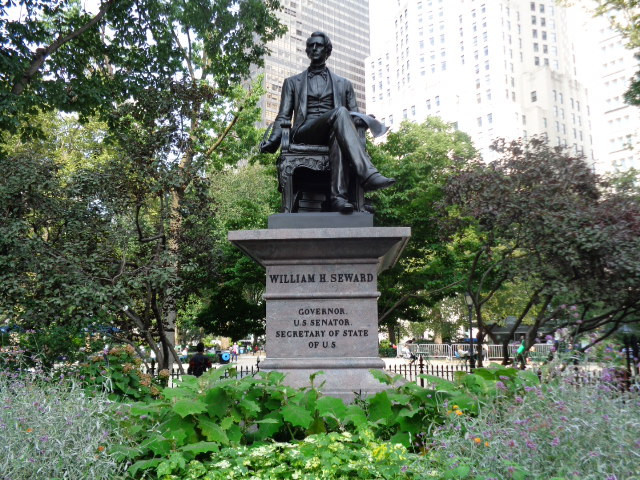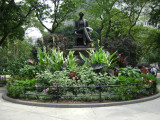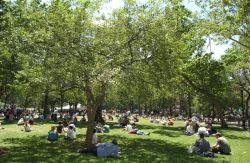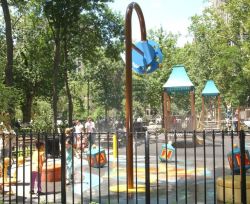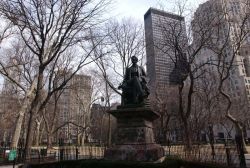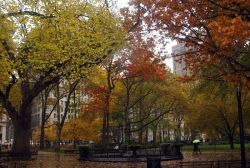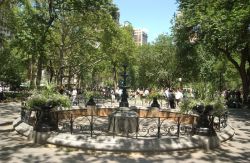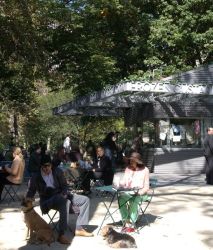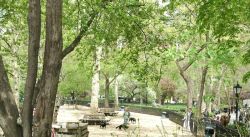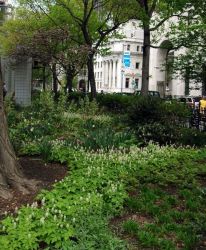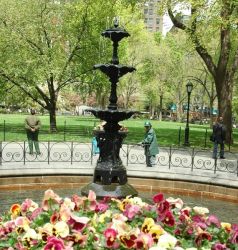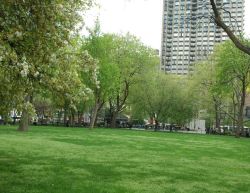Madison Square Park
View all monuments in NYC Parks, as well as temporary public art installations on our NYC Public Art Map and Guide.
William Henry Seward
| Artist: | Randolph Rogers |
| Dedicated: | September 27, 1876 |
| Location: | Fifth Avenue at 23rd St. |
Artwork History
This imposing bronze statue of statesman William Seward (1801–1872) was created by the artist Randolph Rogers (1825–1892). The sculpture was dedicated in 1876, and Seward is said to be the first New Yorker to be honored with a monument in the city.
William Seward was born in Florida, New York, on May 16, 1801. An avid scholar, Seward studied at Farmers’ Hall Academy in Goshen, New York, and in 1816 enrolled at Union College, graduating in 1820. Seward was admitted to the bar at Utica in 1822, and partnered in Auburn, New York, with Elijah Miller. Active in local and national politics, Seward was elected in 1830 as an anti-Masonic candidate to the state senate. Defeated for governor by William L. Macy in 1834, Seward was elected to that position in 1838 as a leader of the anti-slavery wing of the Whig party, and served as governor for two terms, from 1839 to 1843. Afterwards Seward specialized in patent law, and was in great demand too as an attorney in criminal cases. In 1845, he argued in defense of freedom of the press in a libel suit brought by J. Fennimore Cooper (1789-1851) against newspaper publisher Horace Greeley (1811-1872) in 1845. Four years later, Seward was elected United States Senator (1849-1861).
In 1858, he delivered a famous address in Rochester, New York, in which he articulated the “irrepressible conflict” caused by the scourge of slavery in the United States. His prominent position within the Republican Party won Seward the most votes on the first ballot for the presidential nomination in 1860, but the party chose Abraham Lincoln (1809-1865), to represent their interests. Shortly after Lincoln’s inauguration, several southern states withdrew from the union, initiating the bloodiest conflict in American history, the Civil War (1861-1865). Valuing Seward’s powers of persuasion, political acumen and unswerving fealty to the Abolitionist cause, Lincoln appointed him to the position of Secretary of State in 1861 (a position Seward held until 1869).
As Secretary of State, Seward worked to block European recognition of the Confederacy, negotiated the anti-slave trade Seward-Lyon treaty with Great Britain, and brokered the purchase of the Alaska territory from Russia in 1867, often referred to as “Seward’s Folly.” On the night of April 14, 1865 as John Wilkes Booth (1838-1865) assassinated President Lincoln, Seward was attacked by Booth conspirator Lewis Powell (Paine), suffered severe wounds, but survived the encounter. Under President Andrew Johnson, Seward supported reconstruction policies, enduring considerable objections from many within his own party. Retiring from public life, Seward died on October 10, 1872, in Auburn.
In 1873, Randolph Rogers (1825-1892) was asked to create the portrait sculpture of Seward. Rogers was born in Waterloo, New York, and spent much of his childhood in Ann Arbor, Michigan. Moving to New York City in 1847, he began drawing and modeling. His employers, owners of a dry-goods firm, were so impressed with his artistic promise, that they financed his travel abroad. Rogers studied in Florence and Rome, Italy. The experience so transformed him, that though he received numerous public and private commissions in the United States, much of his professional career was spent making art as an expatriate in Italy.
An oft told tale which Rogers did little to dispel, was that his statue of Seward was nothing more than a new head added to a copy of a sculpture of Lincoln he had made, installed a few years earlier at Fairmont Park in Philadelphia. While the two works do bear striking similarities, the size of Seward’s body appears too large, and though the proportion of the head to body seem at odds, the works are by no means identical. Seward is depicted seated, cross-legged in a large armchair, books stacked beneath, with pen and parchment at hand. The statue is situated on a large pedestal of variegated Italian marble. More than 250 subscribers, among them General Ulysses S. Grant (1822–1885) and Commodore Cornelius Vanderbilt (1843–1899), contributed to the monument’s $25,000 cost.
The sculpture, placed on a diagonal facing the intersection of Broadway and 23rd Street at the southwest corner of Madison Square Park, was dedicated on September 27, 1876. Numerous dignitaries, including future president Chester A. Arthur (1829–1886) and General Winfield S. Hancock (1824–1886) attended the proceedings, which were reported to be “fittingly done” without extravagant pageantry, but told “the story of [Seward’s] life, of the perils he encountered and the triumphs he achieved.” In 1995, the sculpture was conserved, and in 2019 the deteriorated pedestal was replaced by a replica in more durable Brazilian-quarried Red Arno granite.
Artwork Details
| Description: | Portrait statue on pedestal |
| Materials: | Bronze, red Levante marble |
| Dimensions: | H: 17'9" W: 7'2" D: 10'1" |
| Foundry: | Ferd V. Miller & Sohne, Munchen |
Inscription
WILLIAM H. SEWARD / GOVENOR / U.S.SENATOR / SECRETARY OF STATE / OF U.S.Please note, the NAME field includes a primary designation as well as alternate namingsoften in common or popular usage. The DEDICATED field refers to the most recent dedication, most often, butnot necessarily the original dedication date. If the monument did not have a formal dedication, the yearlisted reflects the date of installation.
For more information, please contact Art & Antiquities at (212) 360-8163.
Check out your park's Vital Signs
Clean & Safe
Green & Resilient
Empowered & Engaged Users
Share your feedback or learn more about how this park is part of a
Vital Park System
